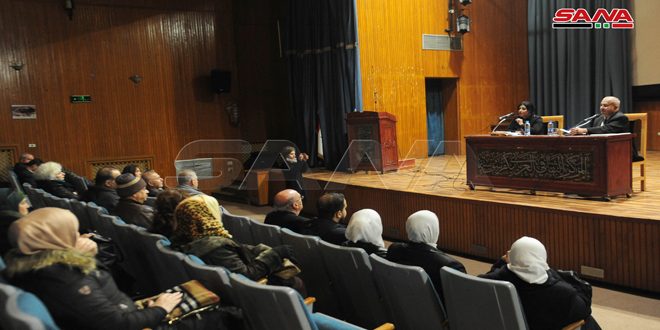Damascus (ST): “Old Damascene Houses, Perfumed Bottles” is the title of a symposium recently held by the Arab Cultural Center in Kafr Sousseh that shed light on different aspects of these houses, their beauty and splendor and their impact on world architecture.
Researcher Ilham Mahfoud, the curator of the Arabic Calligraphy Museum in Damascus, said that the Damascene houses have their own distinguished beauty which is different from others in various cities.
She added that the richness of this city with its archaeological houses prompted the Directorate of Antiquities and Museums to register a large number, take care of them and restore them, including Khaled Al-Azem House, which became the Damascene House Museum of the Levant and the Akkad House which became the Danish cultural centre, as well as many monuments, homes and architectural masterpieces.
Mahfoud went on to say that that poets, thinkers, and orientalists likened the old Damascene house to paradise because it contained beautiful decorations on stone, wood and marble, such as the Persian decoration, and the ceilings ornamented with geometric and linear artistic decorations, poems and wise sayings, reviewing the parts of the Damascene house including Salamlek (men’s department), Haramlek (women’s department), Khadamlek (servant’s department), the fountain and the attic.
Researcher Anas Tello explained that the title of the symposium was inspired by the saying of the Damascene poet Nizar Qabbani: “Do you know what it means for a person to live in a perfume bottle”, pointing out that the tourists who visit Old Damascus search for brotherhood and love and not only architecture, stressing that Damascus has been a melting pot that dissolved all civilizations and produced a unique civilization and homes designed without engineering and science, but with an innate creative art whose impact reached Morocco and Andalusia.
In her intervention, folklore researcher Najla Al-Khadra’a indicated that the Damascene house carries all the high specifications in terms of architecture, decoration and division, underlining the importance of invoking heritage as a duty of the citizen towards his homeland, especially in our days because it is an identity that must be preserved.
Naima Suleiman, head of the Arab Cultural Centre in Kafr Sousseh, clarified that heritage represents a bridge linking the past and the present, and it is our identity that distinguishes us from other peoples, and it is necessary to accord special attention to it, particularly the architecture that is embodied in Damascene houses, where art begins with it from the walls, stones, trees, roses and jasmine climbing its courtyard.
K.Q.

